All advanced work depends on one thing… the correct preparation. German expert Dietmar Specht, outlines a training sequence to make your horse supple, relaxed, rhythmic and confident. A program for every horse – Dressage, Showjumper, Campdrafter or Eventer – they’ll all benefit from this step-by-step exercise program…
As the President of the Ground Jury for the first two Haig Cups, West German Dr Dietmar Specht has taken a keen interest in the development of dressage in Austarlia, and on his last trip to our country he had an important warning to deliver:
“Of course there are different ways to school a horse, but the ways should always lead in the same direction. We start from the same base and we lead in the same direction. That has to be really fixed and made certain is that we have three good paces. We must obtain suppleness, looseness, relaxation and confidence by correct preparatory work.”
Dr Specht also pointed to problems that can arise with visiting instructors:
“The biggest danger is when an instructor is only visiting for two or three weeks and he wants to achieve the best possible results. Sometimes an instructor, because of his great abilities, is tempted to ask too much. To ask for something that neither horse nor rider can cope with. Later on, when the rider is on his own, he must get into trouble, and with the instructor gone, he will not find the way out of the trouble – eventually both horse and rider are thrown back in their development instead of going forward.
The German Federation is carefully vetting instructors before sending them overseas. Instructors should not be invited privately, but the request should come through the respective Federations. We have made up a pool of instructors who are interested in going abroad, and we know we can send a particular instructor to a particular country. We would not send the same instructor to Indonesia as we would send to Australia. We have seen the situation here, and we know what is wanted.
Anne-Grethe Jenson (Denmark) riding Marzog to first place in the European Dressage Championships at Aachen. Dr Specht comments: ‘Piaffe. The horse in full concentration, nevertheless absolutely supple and loose, in attentive, contented carriage. Mark: contented total expression, closed mouth, active hind leg at the highest possible raising of the neck, only slightly taut rein.
In the United States there have been problems because people who invite instructors don’t express clearly enough what they are expecting. If the horse is only at the Medium/Elementary level, there is no instructor in the world who can make it a Grand Prix horse – even in three months.
It is important to have an instructor who is able to follow the development in the country he is working. Then he will know when to go on to the really collected work. We are always dealing with two living beings whose work has to come together. When the horse is ready, that is still only one precondition. Every rider should have the opportunity to learn from an experienced horse.
The whole development of dressage must be handled very carefully. The greatest danger is the temptation to go to fast. There are trainers and horses able to go quickly to more advanced work. They are able to do it because the horses are really experienced. If I sat on a really experienced Grand Prix horse, I would be able to ask for a half pass after a few minutes – and a really experienced trainer even more so. But if both horse and rider haven’t got this experience, then they will almost certainly go in the wrong direction if they try to move too quickly.
Anne-Grethe Jenson and Marzog. Dr Specht comments: ‘The same combination in the main arena at the walk. Contented looseness and an attractive expression. Especially note: in the background, the orchestra plays at the moment of this photo. In spite of the nearness to the music, the horse remains fully concentrated upon his rider and relaxed.
The key to almost everything is the transition. It is quite a misunderstanding to just ride a young horse forward. He must be obedient to the half halts – with the effect of shortening step and stride, without asking for real collection. In a way it is the beginning of collection, but it must not lead to false collection. It doesn’t make any sense to do nothing but ride forward, but again you cannot start too soon with the half halts, it depends on the strength of the horse.
The transitions help to strengthen the muscles of the hindquarters. From working trot to medium trot, working trot to walk, working trot to working canter. All these transitions will help make the muscles of the quarters stronger. The quarters must have the strength before you can ask them to carry more weight. If you ask the horse to take the weight too early, the horse will feel pain and he tries to avoid or escape the weight and becomes tense. Then nothing will work, you have lost suppleness and looseness and you can’t do anything except go back and make the horse supple and loose again.
There are three forces that have to be developed. First the ability of the horse to shift the whole body forward. If this is developed, then next, in combination, is the force to carry weight. The third force is the force of elasticity. Once the horse can move forward and carry, then he develops the possibility of elasticity, then he is able to execute even the most collected movements.
Everything will lead back to the Training Scale.”
Dr Reiner Klimke (West Germany) riding Ahlerich to second place at the European Championships. Dr Specht comments: ‘Piaffe. Highest possible expression of complete suppleness and looseness, contentedness and harmony in exemplary self-carriage. Especially note: very active hind legs in the highest collection, which make the maximum raising in the neck possible. Nevertheless sagging reins, the best proof that the horse is here absolutely collected. Effortless total expression of horse and rider.
As Dietmar points out, the modern German Training Scale – Rhythm, Relaxation, Acceptance of the bridle, ‘Durchlassigkeit’ (letting the aids flow through), Impulsion, Straightness and Collection – is a relatively recent development. The training scale was developed in the German Cavalry School in the early years of this century – based, in part, on the teachings of Caprilli.
“In former times the aim was to have a horse as supple as possible, a horse that could move as quickly as possible, and a horse that was obedient to the requests for collection. Collection was nothing other than self-preservation. The horse that is always carrying the weight on the forehand will not be able to serve as a riding horse for a very long time, the more weight he carries on the quarters the longer he will last as a healthy horse.
While the aims in former times may have been the same, the methods were quite different. The relationship between man and animal was quite different. The selection of horses was quite different.
Fifty years ago horses of every kind were used, and some were horses with not very nice character, and they had to be used in a certain way. Nowadays we are breeding for a certain temperament and we have more favourable horses to work with.
Now we see a combination of the older tradition, and the work of people like Caprilli. Now we work on the basis that we go back to nature and develop everything out of the natural skill and abilities of the horse and not to ask for unnatural things. Every performance develops from the natural talent of the horse.
Haungk developed the Training Scale and brought together the various items in the early twentieth century in connection with the development of the Cavalry School.
Because the elements of the Training Scale belong in sequence, that does not say you cannot work for the second step before you achieve the first. For example, to work for rhythm we must already have, at least to a certain extent, acceptance of the bridle. We do not need straightness right from the start, but we must work for straightness. But without suppleness and looseness you cannot go further, you cannot collect the horse until he is supple and loose. You could not start to straighten or collect until you have rhythm, but you could not get rhythm on a loose rein. The elements all work together.”
Dr Specht rejects the suggestion that the German scale relates particularly to the German breed of Warmblood horse.
“It has been proved that the Training Scale works with the thoroughbred. There are quite a few near Thoroughbred horses in Dressage in Europe. You cannot set any horse back before you are able to push. No matter what breed, every horse must be made obedient to the driving aids.”
In a later talk, after the completion of the Haig Cup, Dr Specht elaborated on the absolute necessity of the correct preparation in every training session.
“Horses and riders are all individuals, nevertheless some general principles must be taken into consideration by all riders for all horses. The first part of the training session, the preparation, is too often neglected. There may be some differences in the construction of the preparatory sessions, but I do offer some systematic suggestions. We are looking to the readiness of the mind and body, which is the indispensible pre-condition of success. In the first phase of the training session we are looking for a body which is supple, flexible, loose: in the mind nothing more than confidence.
Dr Klimke and Ahlerich in the extended trot. Dr Sprecht comments: ‘Here now the concentrated strength of the hind legs, solely directed to the advance-push. The neck correspondingly less raised, but, recognisable at the rein, now as before, in clear self-carriage, thus completely balanced. Notice also the absolute proportionality of the movements of the fore and hind legs.’
Seventy to eighty percent of our work at all levels will be done in the ordinary snaffle because it develops more feeling in the mouth. The more sensitive the mouth, the lighter your aids. First develop the sensitivity, and then when you work in the curb, it will just hang there. You have already achieved the aim of the curb before you start working with it. Lunging the horse first depends on the horse and rider. It must be done correctly if it is to be done at all, and all the same pre-conditions apply. Short side reins are no use at all, give the horse the same opportunities when you lunge him correctly as when you ride him correctly. Lunging can help younger horses or badly behaved horses, or horses lacking in confidence. Lunging is better than starting work with a horse that is tense and contracted giving you no opportunity of supple relaxed work. When you first mount the horse pay attention to absolute immobility for at least half a minute. If you make the horse stand like this every day, then you will have no problems with the first halt and the last halt in the Test – problems we have seen here.
Start work with a free walk on a long rein, there after the given rein. For the first movement the horse must walk energetically forward, the horse must know he is following the rider, not on his own.
Walk for five minutes on straight lines and change the rein repeatedly. This first part of the first phase is not a recommendation, it is compulsory, The horse is becoming familiar with the rider’s weight. Two living beings who want to work together. The rider is becoming familiar with the motion of the horse, he is gaining the confidence of the horse – both are comfortable and relaxed.
In the second phase, we shorten the reins and move to a working rising trot – but not before the horse has accepted the bit. There are some advanced horses who accept the bit without resistance, and they may be started in the working trot sitting or even the canter. The working trot is the only pace in which the legs are working simultaneously on both sides. It is therefore the best pace to make the horse supple, loose and confident.
Move the horse forward energetically, paying attention to an even rhythm. Take your time in this phase. Trot for ten minutes on big curved lines, on circles of twenty metres in diameter, on big loop serpentines. Change rein repeatedly, and work more on the difficult side, usually the right side.
This work on the circles and serpentines makes the horse accept the outside rein by use of the clear driving aids of the inside leg. The entire outside rein should be as close as possible to the horse’s neck. The horse needs support. The limiting position of the outside leg, the flexing influence of the inside leg and hand – the so-called diagonal aids.
Uwe Sauer (West Germany) riding Montevideo to third place in the European Championships. Dr Specht comments: ‘Passage. Development of maximum thrust and elasticity from the hind legs at absolute suppleness and looseness, and above all, contentedness in the poll. Especially note: play of the ears concentrated on the rider, completely closed contented mouth.’
If you experience problems of rhythm or of acceptance of the bridle, go on the circle and work with the diagonal aids, and your problems will go in a few minutes. In using the diagonal aids, bring more weight to your inside seat bone and inside stirrup, but never press the inside hand down or cross the inside hand over the neck or the withers. The outside hand should never be higher than the inside hand. The only effect of raising the outside hand is to make the horse tilt his head, and once the horse has learned to escape by tilting his head, it will require a lot of work to resolve the problem.
During the first ten minutes we are still using big curving lines and still in a working trot. After ten minutes begin to include half halts and change between a rising and sitting trot, just for a few steps and the horse will automatically shorten the stride and lengthen it when you resume the rising trot.
The half halt is a short period in which the rider exerts a concentrated, combined action of all the aids, in which the driving aids prevail – it ends with the rider’s hands giving as the horse gives. It is never a drawing action. You must feel when the mouth of the horse is giving, and the rider must give in response, especially with the inside hand.
Now we can move to some straight lines to lengthen the steps even more. The horse will lengthen in the working trot, but we are still not asking for the medium or the extended trot.
After fifteen minutes work, the horse should have a five minute break of free walk. We want the horse to be supple and loose not tired. You can’t work with a tired horse.
When we resume, we start to introduce halts – not only on the track or the centre line, bur where ever we are. We don’t always need to work in an arena. For concentrated work it is very good, but not every day in the arena. When we ask for a halt we ask for a halt of at least fifteen seconds immobility – then we will have no problems in the Test. If the horse insists on moving too early, feel this before he moves and react immediately and make him move a few metres then halt again. Keep repeating this exercise and you will have no problems with the halt.
After our break we go back to working on circles. Repeat the transitions from rising to sitting trot. Introduce leg yielding, or short leg yielding, on the open sides of the circle in the sitting trot – but do not ask for too much angle or the horse will lose rhythm and become tense.
Start work on the transition from working trot to working canter. The best place to make a transition is always at the end of the open part of the circle, as the horse returns to the wall, Every transition will help develop strength. Later on we will want the horse to carry his and our weight on the hindquarters and we must develop the strength to do that. There is no better way than by using transitions. All horses know how to move from trot to canter, the crucial element is the rhythmical flow of the transition.
Now we can include straight lines and the lengthening of the stride in the canter, making sure we work equally on both reins.
At the end of the second phase after twenty to twenty-five minutes, return to the working trot sitting. Drive with your legs and open the hands slightly. The horse should lengthen his stride but not lower his neck. If the horse does this without hurrying that will show you that the initial work was correct, he is now ready for the more difficult work – collected work. The purpose of the second phase was to make the horse’s muscles, tendons and joints ready for more exerting work. We have developed and kept an even rhythm in all the three paces, the horse is supple, loose and flexible, and willingly accepts the bit without resistance. Thehorse moves forward energetically with impulsion. He follows curved and straight lines and has theability to remain straight. He is obedient to the driving, flexing and uniting aids.
The rider must also be supple or he will make the horse tense. You must develop a special feeling for your horse every day. Everything is developed out of the feeling of the rider for what is going to happen, before it happens and provoke resistance. We develop the horse’s mind and confidence – without confidence we achieve nothing.
We have worked twenty-five minutes, now it is time for another phase of regeneration with a short break of free walk on a given rein Our aim is to let the horse recover, hut without losing his attention The rider now has the opportunity and the obligation to concentrate on the aims of the next real working phase. But moving to this stage, he must evaluate and plan on the basis of the day’s work and the previous work.
The rider may try for the more advanced work without going through the earlier work, but he will almost certainly fail, and the effect on the horse will be damaging.
“The only guarantee of satisfaction is careful preparation.”
This article originally appeared in the March, 1984 edition of The Horse Magazine

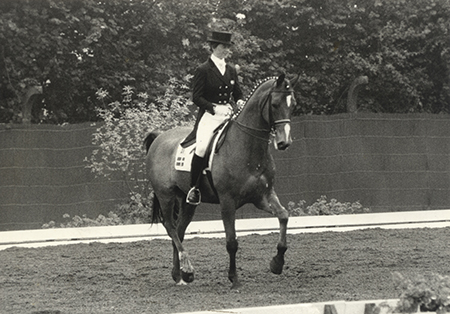
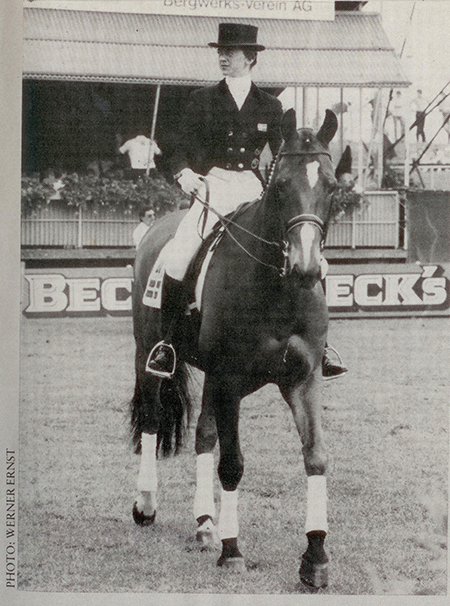
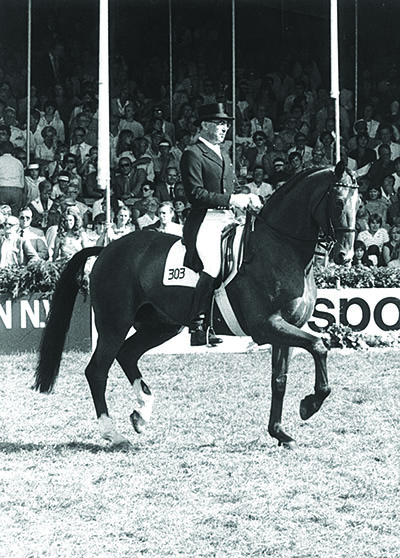
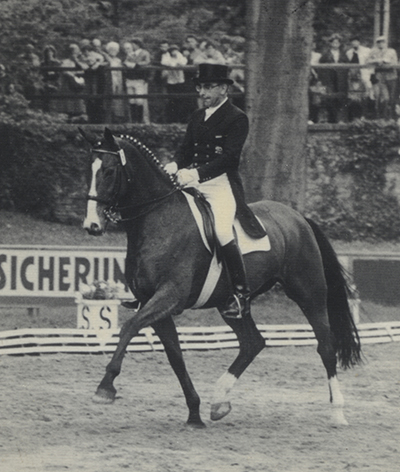
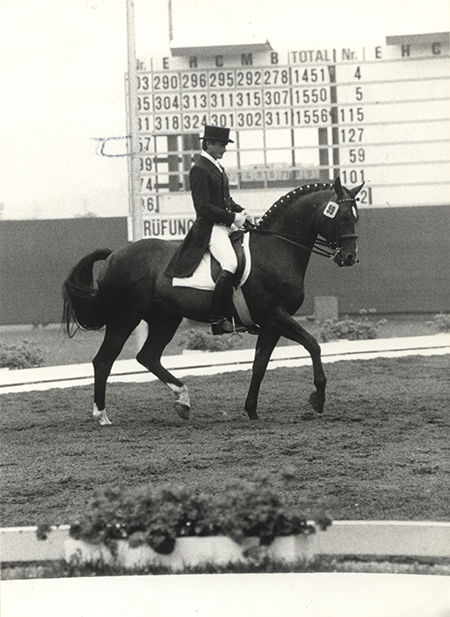
I would like to know the reason Owe Sauers horse was named Montevideo.
I am from Uruguay and the capital of the country is Montevideo, mabye there is an interesting story behind it.
Thanks, Sofía.